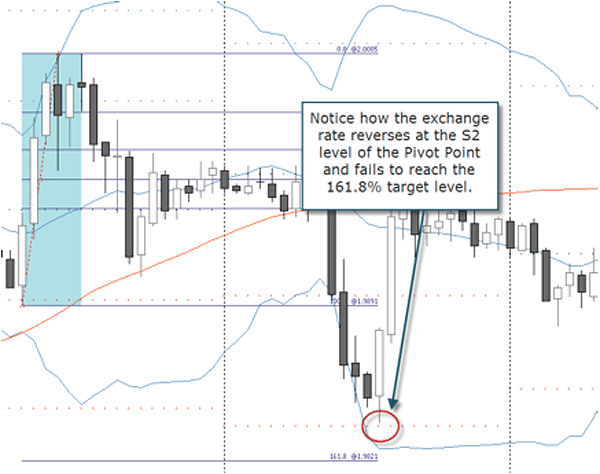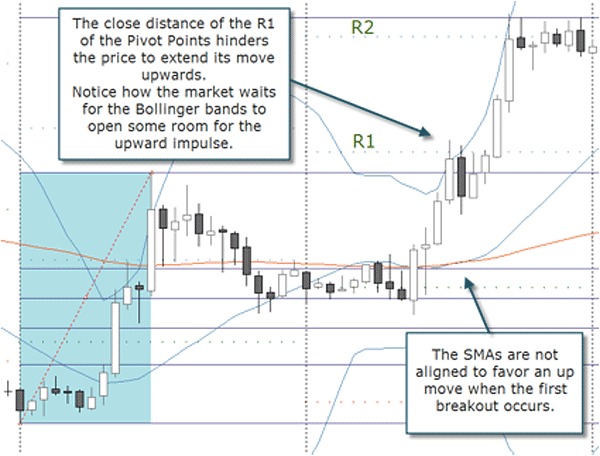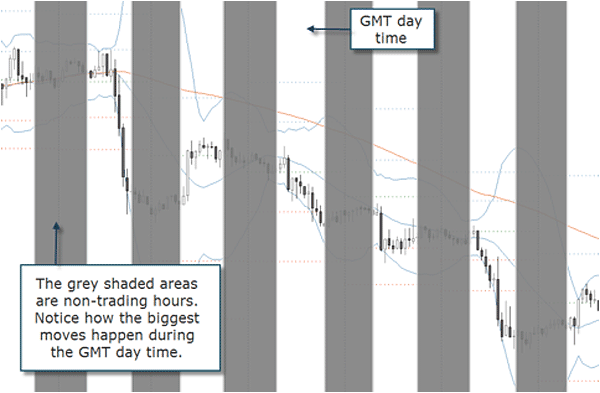4. Fine-tuning a Trading System
There is always a certain level of uncertainty in the markets and the trader's task is to find a method that is right most of the time, or that is at least able to accumulate profits, knowing that no system is 100% accurate. All we need statistically is a legitimate edge. Several elements help to build this edge, and one of them is what we have been covering in this chapter: building a systematic approach to guide our actions in the market place.
Another essential step in building a trading method is to backtest and forwardtest your system before committing real money.
Backtesting
No serious trader would employ a systematical trading approach without first thoroughly backtesting it. Backtesting is no doubt a tedious process, but fortunately there are platforms to help you perform it manually and/or automatically.
Since you have already fully described and translated your trading approach into a set of rules, backtesting is as simple as executing them. Backtesting is a method of simulating the rules along sufficient historical data to test their effectiveness. By using historical (past) data, you are saving a lot of time: imagine to test a strategy on the 4H chart with a trade frequency of two trades per week. It would take approximately one year to accumulate 100 trades - can you wait so long?
A great deal of testing may be required in order to gain confidence in the system's ability to perform in the market, and the results may disappoint you many times! New traders often confound an “opportunity scanning”, that is, the visual search for valid entry signals on the charts, with a proper statistical test. A system may look very promising when you train the eye to search for the valid and profitable signals, but once submitted to backtesting, the results may defy your understanding.
The effectiveness of backtesting relies on the assumption that what happened in the past is likely to happen in the future. But in order to encompass all kinds of market conditions and possible scenarios, make sure your system is tested on sufficient data. Give the system enough time to work out: for example, a time span of months to a year may be enough to see if the system was profitable or not. Always keep in mind that your backtesting results are quite dependent of the market behavior during the tested period of time - for this reason the backtested results are always hypothetical and do not guarantee future results.
So why bother backtesting if past results can't guarantee future results? Because in trading the statistics does help us to define an edge, that is, a greater possibility for one thing to happen. Here we must use the word possibility, because we are dealing here with probabilities.
When building a system you want to look for patterns in price that repeat with some frequency. You want to repeat what has worked and avoid what hasn't. Therefore you need to go back in time and determine how many of those patterns were profitable, what was their frequency, and so on. This is where backtesting is useful: to measure your edge.
Markus Heitkoetter's “Day Trading Series” webinars were recorded. In Developing a Profitable Trading Strategy (Part 2), Markus shows how he starts applying and testing an idea live on his platform with a systematic approach.
How the system described in the previous section would be enhanced after backtesting a certain amount of trades? We would, for example, add a filter to the take profit exits after observing that the daily Pivot Points act strongly as support resistance. Sometimes the price stops at a R or S level of the Pivot Point and reverses, failing to hit the target by a few pips.

We have also noticed that when a S or R level of the Pivots is very close to the entry point, we are likely to experiment a false breakout. The below illustration is a winning trade which was filtered by two conditions on the first breakout attempt.

Therefore we want to add the following rules into our next round of testing:
- The target will be the 161,8% Fibonacci extension level OR a S/R level of the Pivots which is closer to the entry price. As a condition, a trade will only be taken if that day the distance of the 161.8% and any S/R level is equal or lower that 15% of the previous daily range.
- If a S/R Pivot level is closer than 10 pips from the entry price, the S/R level will be considered the new entry level. Don't forget to add 1 pip and the spread when entering long.
After making some amendments to your rules, you can go on for a second round of backtesting. How many times you will have to repeat the process will depend on the results obtained.
While historical backtesting will help indicate the profit potential of a system, it will never be able to recreate exactly the real trading conditions. For this reason you need a last step before using the system with real money: the forwardtesting.
Forwardtesting
Also called “demo trading” or “paper trading”, forwardtesting is the execution of a system in real time, this means you have to make live decisions, but you are operating in a simulated environment. Nowadays, most of the Forex brokers offer online demo accounts for free which have the full capabilities of a real account, so you don't need to keep track of your performance on paper.
Trading a demo account will enable you to test all the aspects learned in this chapter without upfront costs or the risk of loss.
Forwardtesting is much more time consuming than backtesting since it doesn't rely on historical data. Depending on the strategy, it might take weeks or even months until you have enough data for a statistically relevant performance report. For this reason, make sure you backtest extensively before starting with the forwardtesting. The reasons traders go through a demo trading stage before they apply a system in real conditions is because certain aspects can't be assessed with backtesting.
Some of the conditions which have to do with your trading profile can't be totally recreated in a simulated environment. The forwardtesting, or demo trading, will show if the trade frequency of the system and the duration of the trades will be in your comfort zone. You have to experiment how it is to sustain a position against you overnight to decide if you are able to withstand that with real money or not.
The demo trading will help you to get a feel of the market rhythm, and at the same time, it makes you gain the so much needed confidence when it comes to executing the signals.
Backtest and forwardtest your strategies until your numbers suggest you could trade with real money. Never put your hard-earned money at risk until you have accomplished these two phases.
What kind of conclusion can you arrive to when forwardtesting the breakout system? For instance, you may realize that the system produces signals out of your time window. Perhaps you haven't noticed it during the backtesting, but many signals are generated during the hours that you normally sleep. Following this observation, you can add another rule which states:
- We will only take positions between 8:00 and 17:00 GMT time.

While reading and understanding this material helps to build a strong foundation, you must realize that you have to go a little bit further. Our actions are governed not only by knowledge but by custom, precedent and habit. The only way to use the knowledge is applying it through a conscious and determined effort, not by storing it. To truly become a successful trader, you need to take what you have learned here and start applying it.
Would you like to share ideas with other traders who are just starting to build their systems? Fell free to drop your market observations or any hypothesis on which to develop a system at the LC Forum. If you are already back- or forwardtesting, maybe you can inspire other forum members to do the same.
We hope you have appreciated the benefits of developing a trading methodology. There is probably no better way to improve trading results than to develop and implement trading systems that you understand and which suit your personality and situation. The aim of this chapter was to help you accomplish that.
What have you learned from this chapter:
- With dedication and research, you can develop your own trading system.
- A system helps to keep your emotion at bay: in the heat of trading it is a lot easier to refer to a written checklist than to left over intentions since the last trade.
- The best system is a self-made one because you can never feel comfy in borrowed shoes although borrowing good ideas from others is a good way to start building your edge.
- If you intend to become an independent trader you will have to develop methods to manage your market exposure and control your trading risk without the support of a trading team.
- There is no reason to risk money on a trading theory that has not been tested. Backtest your trading idea before putting your money at risk.
FXstreet.com contents:
- Trading Systems I, by Dan Blystone
- Trading Systems II, by Dan Blystone
- Trading Ranges − ITC 2008 presentation, by Derek Frey
- Day Trading Series - Chapter III: Developing a Profitable Trading Strategy (Part 1), by Markus Heitkoetter
- Day Trading Series - Chapter III: Developing a Profitable Trading Strategy (Part 2), by Markus Heitkoetter
- Day Trading in the Forex and Related Markets: How to Develop a Profitable Trading Strategy, by Markus Heitkoetter
- Signal Selection, by Scott Owens
- Bollinger Bands and RSI, by Valeria Bednarik
- My favorite technical indicators to trade Forex, by Valeria Bednarik
- The Six Forces of Forex, by Scott Owens
- Effectively Using Stop Losses, by S. Wade Hansen
- Facts, Fiction and Truth About Day Trading, by Markus Heitkoetter
- Forex Trading Strategies Section
- Trading Range bound and Trending Markets, by Adam Rosen
- Forex Mechanical Trading Systems: What Every Trader Should Know, by David J. Lyder, Sr.
- Forex Trading System, by Dima Chernovolov
- Understand your Trading System, by Mike Baghdady
External links:
- Your exit strategy determines your profits, by Financialmarketfisherman.com
- Your trading system and building on the basics, by Financialmarketfisherman.com





